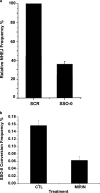Sequence conversion by single strand oligonucleotide donors via non-homologous end joining in mammalian cells
- PMID: 20489199
- PMCID: PMC2906313
- DOI: 10.1074/jbc.M110.123844
Sequence conversion by single strand oligonucleotide donors via non-homologous end joining in mammalian cells
Abstract
Double strand breaks (DSBs) can be repaired by homology independent nonhomologous end joining (NHEJ) pathways involving proteins such as Ku70/80, DNAPKcs, Xrcc4/Ligase 4, and the Mre11/Rad50/Nbs1 (MRN) complex. DSBs can also be repaired by homology-dependent pathways (HDR), in which the MRN and CtIP nucleases produce single strand ends that engage homologous sequences either by strand invasion or strand annealing. The entry of ends into HDR pathways underlies protocols for genomic manipulation that combine site-specific DSBs with appropriate informational donors. Most strategies utilize long duplex donors that participate by strand invasion. Work in yeast indicates that single strand oligonucleotide (SSO) donors are also active, over considerable distance, via a single strand annealing pathway. We examined the activity of SSO donors in mammalian cells at DSBs induced either by a restriction nuclease or by a targeted interstrand cross-link. SSO donors were effective immediately adjacent to the break, but activity declined sharply beyond approximately 100 nucleotides. Overexpression of the resection nuclease CtIP increased the frequency of SSO-mediated sequence modulation distal to the break site, but had no effect on the activity of an SSO donor adjacent to the break. Genetic and in vivo competition experiments showed that sequence conversion by SSOs in the immediate vicinity of the break was not by strand invasion or strand annealing pathways. Instead these donors competed for ends that would have otherwise entered NHEJ pathways.
Figures







Similar articles
-
The role of nonhomologous DNA end joining, conservative homologous recombination, and single-strand annealing in the cell cycle-dependent repair of DNA double-strand breaks induced by H(2)O(2) in mammalian cells.Radiat Res. 2008 Dec;170(6):784-93. doi: 10.1667/RR1375.1. Radiat Res. 2008. PMID: 19138034
-
Extensive ssDNA end formation at DNA double-strand breaks in non-homologous end-joining deficient cells during the S phase.BMC Mol Biol. 2007 Oct 26;8:97. doi: 10.1186/1471-2199-8-97. BMC Mol Biol. 2007. PMID: 17963495 Free PMC article.
-
Targeted gene knock in and sequence modulation mediated by a psoralen-linked triplex-forming oligonucleotide.J Biol Chem. 2008 Apr 25;283(17):11244-52. doi: 10.1074/jbc.M800607200. Epub 2008 Feb 25. J Biol Chem. 2008. PMID: 18303025 Free PMC article.
-
Crosstalk between different DNA repair pathways for DNA double strand break repairs.Mutat Res Genet Toxicol Environ Mutagen. 2022 Jan;873:503438. doi: 10.1016/j.mrgentox.2021.503438. Epub 2021 Dec 15. Mutat Res Genet Toxicol Environ Mutagen. 2022. PMID: 35094810 Review.
-
[Double strand break repair, one mechanism can hide another: alternative non-homologous end joining].Cancer Radiother. 2012 Feb;16(1):1-10. doi: 10.1016/j.canrad.2011.05.004. Epub 2011 Jul 6. Cancer Radiother. 2012. PMID: 21737335 Review. French.
Cited by
-
Targeting of an interrupted polypurine:polypyrimidine sequence in mammalian cells by a triplex-forming oligonucleotide containing a novel base analogue.Biochemistry. 2010 Sep 14;49(36):7867-78. doi: 10.1021/bi100797z. Biochemistry. 2010. PMID: 20701359 Free PMC article.
-
Targeted gene therapies: tools, applications, optimization.Crit Rev Biochem Mol Biol. 2012 May-Jun;47(3):264-81. doi: 10.3109/10409238.2012.658112. Crit Rev Biochem Mol Biol. 2012. PMID: 22530743 Free PMC article. Review.
-
Single-Stranded DNA-Binding Proteins Mediate DSB Repair and Effectively Improve CRISPR/Cas9 Genome Editing in Escherichia coli and Pseudomonas.Microorganisms. 2023 Mar 27;11(4):850. doi: 10.3390/microorganisms11040850. Microorganisms. 2023. PMID: 37110272 Free PMC article.
-
Regulation of Gene Editing Activity Directed by Single-Stranded Oligonucleotides and CRISPR/Cas9 Systems.PLoS One. 2015 Jun 8;10(6):e0129308. doi: 10.1371/journal.pone.0129308. eCollection 2015. PLoS One. 2015. PMID: 26053390 Free PMC article.
-
Recent Advancements in Development and Therapeutic Applications of Genome-Targeting Triplex-Forming Oligonucleotides and Peptide Nucleic Acids.Pharmaceutics. 2023 Oct 23;15(10):2515. doi: 10.3390/pharmaceutics15102515. Pharmaceutics. 2023. PMID: 37896275 Free PMC article. Review.
References
Publication types
MeSH terms
Substances
Grants and funding
LinkOut - more resources
Full Text Sources
Other Literature Sources
Research Materials
Miscellaneous

